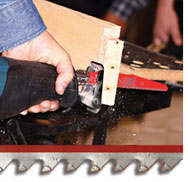Making it Stick
Our topic this month deals with one of the most confusing and poorly understood items that we all drag around in our tool boxes: ADHESIVES. What is the difference between glues and adhesives? Nothing—they both stick things to things—although some would say that glues are thin and adhesives are gap filling, or glues are DIY and adhesives professional.
 |
But before we get into all the sticky stuff, I’d like to start this column with my Blade of the Month.
Diablo wins this month with a carbide tooth recip saw blade. The tiny carbide teeth, laser welded to the blade for rough use, allow this blade to cut through tough stuff including nails and hardened drywall screws without breaking teeth. Yet this is not a carbide “grinder”— it has real sharpened carbide teeth, meaning that it will cut rapidly through wood as well. Unlike bi-metal blades that work best with constant contact, this blade works best with an aggressive orbital action: new for a blade cutting fasteners. This makes for a rapid cut through all material. This Freud laser welding technology applied to Diablo reciprocating blades may be breaking new ground in demolition and renovation work.
A Sticky Situation
We all use a small variety of adhesives, ones that we are comfortable working with but there are so many different adhesives commonly available, you might discover that there is a better one for the job at hand that you didn’t even know existed. There are several critical considerations before picking an adhesive for any given job:

Structural vs. Non-structural
Adhesives that are flexible when cured are not appropriate for any structural application. Structural joints should not slip. Although we often use silicone sealant as an adhesive to hold a countertop down to the counter frame, silicone, which is a form of rubber, must never be used where slippage might be a problem. Contact Cement is not a structural adhesive. PL Premium cures rock hard and is one of many truly structural adhesives. Carpenter glues in tight-fitting joints cure hard and will not slip, and so are considered structural for chairs and the like.
Tight Fit vs. Gap Filling
Adhesives that flow a lot, like slow setting epoxies or carpenter glues, as well as ones that tend to foam a lot, like liquid polyurethanes (Gorilla Glue) will not remain strong across a gap. Non-shrinking adhesives, like PL Premium or epoxy sticks and putties, stick to both sides of the joint and carry full strength across the gap.
The Marriage Bond
Years ago, LePage had a great chart to help with gluing dissimilar materials because it rated each glue type for each material type: good - better - best. Search for “Adhesive Chart” on my website and you can still find it. With the bond of leather and glass, for example, no one type of glue is rated “Best” for both leather and glass. However, since cements are rated “Best” for leather and “Better” for glass, contact cements would be the choice for this marriage bond.
Speed of Setting
The primary difference between white and yellow carpenter glues is the speed of set: they are both stronger than the wood fibres they are holding together, so relative strength is a false distinction. Therefore, you would use white carpenter glue when you need time for a complicated assembly and yellow carpenter glue when you want your clamps back as soon as possible.
Weather or Not
Most adhesives adhere best to dry surfaces, yet adhesives activated by moisture, like silicones and polyurethanes, can actually adhere better to slightly moistened surfaces. Wet surfaces dilute the adhesive and are never good. Even when using underwater adhesives, they must be “worked into” the surface, which essentially means squeezing all the water out between the adhesive and the surface. If you aqua plane, it doesn’t stick for long.
Gluer Beware: “water resistant” adhesives can be used outdoors but not in standing water. Sitting in water requires “waterproof” adhesives or “underwater” adhesives.
Outdoor use of adhesives can be limited by all the aspects of weather. Careful reading of the fine print on packaging will give you the specific information, but for a general guide I have combined your local weather report with construction weather limitations for you: go to www.CTV.ca/weather and scroll to the bottom. Check out the little window “Weather Restrictions for Home Renovations” and go to Adhesives.
Shelf Life
We all know that a dried up bottle or tube is no good, but unfortunately we all try to still use that “thickened” tube that still flows, still sticks, but is harder to work with. The reality is that if it doesn’t flow as well onto and into the surface, even if it can cure properly, it probably has not made as good a bond with the surface as a fresh adhesive. Generally speaking, most adhesives have a one-year shelf life. This is especially true with construction adhesives in gun cartridges. When they are getting difficult to gun, the best advice is to throw them out.
Still Stuck? In our July issue, Jon will deal with some common adhesive application errors and tips. Stay tuned!
Montreal-based TV broadcaster, author, home renovation and tool expert
Jon Eakes provides a tool feature in each edition of Home BUILDER.
www.JonEakes.com


